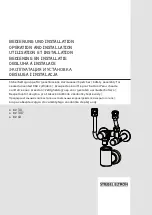
13
• Thoroughly clean and flush system before connecting to
boiler.
• If oil is present in system water, use approved detergent
to wash system.
• It is necessary to semi-annually check the water quality
of central heating systems.
• Flush system to remove any solid objects such as metal
chips, fibers, or Teflon tape, etc.
• Install a magnetic dirt separator in the hydronic system
where there are cast iron or steel components, or where
the previous boiler was a cast iron heat exchanger. The
abrasive, extremely fine sediment is difficult to remove
and can deposit onto heat exchanger surfaces and
accumulate in pump cavities causing reduced efficiency
and premature wear.
• Use purge valve to flush zoned systems, each zone
separately. If purge valves and isolation valves are not
installed, install them to properly clean the system.
• When purging installations that include standing iron
radiators and systems with manual vents at high points,
start with nearest manual air vent. Open the vent until
water flows out, then close vent. Repeat this procedure,
working toward furthest air vent.
• Install a basket strainer if large amounts of sediment is
present. Keep basket clear of sediment build up.
• Flush system until water runs clean and piping is free of
sediment.
• Manufacturer recommends a water treatment product
be used for sediment removal.
5.2 Special Conditions
Note
• System piping exposed to freezing conditions: Use
inhibited propylene glycol solutions certified by fluid
manufacturer for use with closed water heating system.
Do not use automotive or ethylene glycol.
• Boiler installed above radiation level (or as required
by authority having jurisdiction). Integral low water
pressure switch is provided in boiler.
• Boiler used in connection with refrigeration system.
Install piping in parallel with boiler, with appropriate
valves to prevent chilled medium from entering boiler.
• System piping connected to heating coils located in air
handling unit exposed to refrigerated air circulation.
Install flow control valves or other automatic means to
prevent gravity circulation of boiler water during cooling
cycle.
5.1 General
• Primary/Secondary piping required.
• Install piping in accordance with authority having
jurisdiction.
• Support system piping and safety relief valve discharge
piping. Boiler's internal piping and wall mount bracket
can be damaged if subjected to excessive weight.
• Size central heating pump (and domestic hot water
pump, if used) for system requirements only. Internal
heat exchanger pump compensates for pressure drop
through boiler internal piping and heat exchanger.
FIGURE 5-1 Safety Relief Valve
Note
GMHB227
- Boiler rated at 50 psig (3.5 Bar)
maximum allowable working pressure.
GMHB380
- Boiler rated at 80 psig (5.5 Bar)
maximum allowable working pressure.
Boiler provided with 50 psig (3.5 Bar) safety relief
valve.
WARNING
• Poison hazard. Ethylene glycol is toxic. Do not
use ethylene glycol.
• Never use automotive or standard glycol
antifreeze, even ethylene glycol made for
hydronic systems.
• Ethylene glycol can attack gaskets and seals used
in hydronic systems.
• Do not use petroleum based cleaning or sealing
compounds boiler system.
• Do not fill boiler or boiler system with softened
water.
• Use only inhibited propylene glycol solutions
certified by fluid manufacturer as acceptable for
use with closed water heating system.
• Thoroughly clean and flush any system that used
glycol before installing new Boiler.
• Provide user with Material Safety Data Sheet
(MSDS) on fluid used.
!
Do not expose boiler and condensate piping to
freezing temperatures.
Safety Relief
Valve
Note
When installing safety relief valve it must be
installed in a vertical position with spindle at top.
TP Gauge
PN 240012369, REV A [08/31/2018]
5 - HYDRONIC PIPING














































